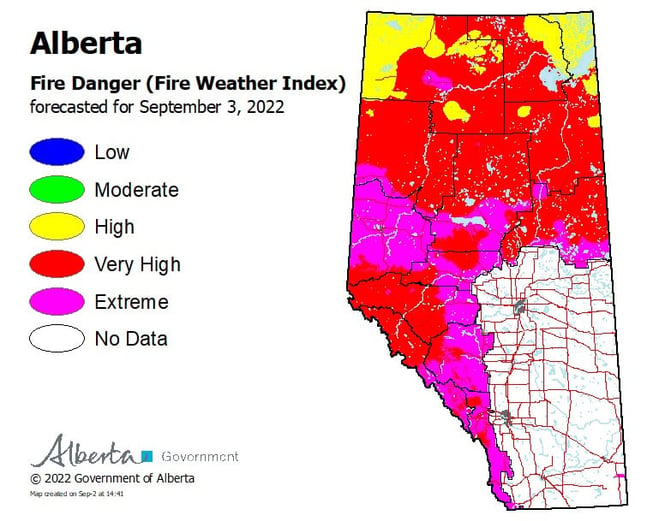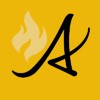
The fire danger in the Fort McMurray Forest Area is overall VERY HIGH. The Fort Chipewyan area is considered HIGH.
A FIRE ADVISORY is in effect for the Fort McMurray Forest Area.
Please use caution when working or recreating in the outdoors. Always ensure you fully extinguish your campfire and if you see smoke or flame in the forest, call 310-FIRE (3473).

Tomorrow's forecasted map of the fire danger throughout Alberta (September 2, 2022).

A FIRE ADVISORY is in effect for the Fort McMurray Forest Area.
Due to current and forecasted weather conditions, no new permits will be issued. All existing permits remain valid but renewals will be considered on a case-by-case basis.
Prohibited:
- Burning without a valid fire permit, other than a campfire, is prohibited.
Allowed:
- Safe wood campfires*
- Backyard fire pits
- Portable propane fire pits
- Gas or propane stoves and barbecues
- Catalytic or infrared-style heaters
*Safe wood campfires - should be within a metal, brick, or rock fire ring. They are required to:
- be on rock, gravel, sand, or another non-combustible surface that extends at least one metre around the fire;
- have a responsible person in attendance to keep fire under control at all times and extinguish before leaving;
- have on hand enough water on site to extinguish the fire. Safe wood campfires on private lands include private land campgrounds and private land recreation areas; and
- Municipalities, Parks and protected areas may have additional fire safety requirements.
Never leave a campfire unattended. Soak it, stir it and soak it again until cool to the touch to ensure it is extinguished. If you see a wildfire, report it immediately by calling 310-FIRE.
Remember that without a fire permit fireworks are not allowed.
The fire advisory will remain in effect until conditions improve.
Please visit albertafirebans.ca to see a map of the exact area covered under this Fire Advisory.
SEPTEMBER LONG WEEKEND
Temperatures over the long weekend are forecasted to be low to mid-30s. With this in mind, please be cautious when recreating outdoors as the risk of wildfires starting and spreading quickly increases with high temperatures.
While it may feel like summer is coming to an end, wildfire season doesn’t officially end until October 31. Wildfires can start anytime of year if the conditions are right. Please use caution in the forested areas if you are out this long weekend.
Alberta Wildfire typically sees an increase in human-caused wildfires during long weekends. Last year, 67% of wildfires were human-caused. We all have a role to play to prevent them.
We have been experiencing hot, dry conditions for a while in the province which can escalate the wildfire danger in parts of the province. This means that wildfires can start easily and spread quickly. If you see smoke or fire in the province, report it by calling 310-FIRE.
FORT MCMURRAY WILDFIRE UPDATE
Since January 1, 2022, there have been 106 wildfires in the Fort McMurray Forest Area, burning a total of 117,094.58 hectares (ha). There are currently 32 active wildfires in the Fort McMurray Forest Area, 31 are classified as being held and one is classified as under control:
MWF015 was detected on June 12 and located 24 km southeast of Fort Fitzgerald, 45 km southeast of Fort Smith and 115 km north of Fort Chipewyan. It is currently estimated to be 3,992 ha in size and classified as being held. This wildfire was caused by lightning.
MWF018 was detected on June 13 and is located 28 km southeast of Fort Fitzgerald, 43 km southeast of Fort Smith and 90 km north of Fort Chipewyan. It is currently estimated to be 2,942 ha in size and classified as being held. This wildfire was caused by lightning.
MWF022 was detected on June 13 and is located 58 km southeast of Fort Fitzgerald and 62 km northeast of Fort Chipewyan. It is currently estimated to be 31,395 ha in size and classified as being held. This wildfire was caused by lightning.
MWF025 was detected on June 14 and is located 30 kilometers east of Fort McMurray. It is currently estimated to be 1,554 ha in size and is classified as being held. The wildfire is moving east and away from the city of Fort McMurray. This wildfire was caused by lightning.
MWF031 was detected on June 25 and is located 21 km north of Fort Chipewyan. The wildfire is estimated to be 61,993 ha in size and was caused by lightning. The south end of the fire from the Roche River past the east side of Flett Lake is now controlled from ongoing suppression efforts. Although still classified as being held, this wildfire is not anticipated to threaten any community or surrounding cabins from this point forward.
MWF032 was detected on June 26 and is located nine kilometers east of Gypsy Lake. It is currently estimated to be 6,476 ha in size and is classified as being held. This wildfire was caused by lightning.
MWF033 was detected on June 30 and is located 30 km southwest of Fort Fitzgerald and 110 km north of Fort Chipewyan. It is currently estimated to be 1,863 ha in size and classified as being held. The fire has reached the west side of Leland Lake. This wildfire was caused by lightning.
MWF034 was detected on June 30 and is located 50 km southeast of Fort Fitzgerald and 90 km north of Fort Chipewyan. It is currently estimated to be 1,301 ha in size and classified as being held. This wildfire was caused by lightning.
MWF074 was detected on August 17 and is located 11 km south of the Northwest Territories border and 16 km west from the Saskatchewan border. It is currently estimated to be 1,716 ha in size and is classified as being held. This wildfire was caused by lightning.
MWF077 was detected August 20 and is located in the wildfire management zone, meaning there are no values at risk. It is currently estimated to be 1,040 ha in size and is classified as being held. This wildfire was caused by lightning.
MWF081 was detected on August 20 and is located on the southeast edge of Bocquene Lake. It is currently estimated to be 190 ha in size and is classified as being held. This wildfire was caused by lightning.
Since these wildfires are located in remote areas where they do not threaten communities or resources, we allow the wildfires to play out their natural role onto the landscape under the watchful eye of experienced fire managers. Using this wildfire management strategy has many benefits. It re-introduces fire onto the landscape, creates a break in the continuous fuels, reduces the intensity of the fire, provides safety zones for our firefighting crews to work from and reduces the cost of fighting these wildfires.
These wildfires are actively monitored by firefighters on a regular basis and do not threaten any communities at this time.
To learn more about the classification of wildfires, please click here.
To view a map of all the wildfires in the area north of Lake Athabasca, click here.
To view the wildfires on a map, check out the wildfire dashboard. It provides up-to-date wildfire information at the click of a button. This interactive tool displays important statistics on the number of active wildfires in the province, sizes, locations, suspected causes and more.
PROVINCIAL WILDFIRE UPDATE
Since January 1, 2022 in the Forest Protection Area, there have been 1033 wildfires burning a total of 141,307.29 ha.
BE CAREFUL WHEN RECREATING OUTDOORS
How OHVs Can Start Wildfires
- Exhaust systems heat up to temperatures in excess of 204 degrees Celsius; hot enough to fry an egg and start a wildfire.
- At these temperatures, built up materials and debris on your machine (such as grass, muskeg, moss, or other debris) can heat up, smoulder and ignite.
- The smouldering debris can drop to the ground as you’re riding, starting a wildfire.
Help Reduce the Risk
You can reduce the risk of your vehicle causing a wildfire by following these simple steps:
- Before you ride, clean out hot spots and remove debris from your machine.
- After riding through muskeg or tall grass, stop and remove any build-up from your machine.
- Carry firefighting equipment such as a small shovel, collapsible pail or fire extinguisher.
- Wash your quad, trike or bike and keep it clean; do not wash in streams and creeks.
- Make sure your muffler and spark arrestor are working properly.
- Stop frequently. Take the time to knock debris from your machine’s hot spots. If the debris is smouldering, soak it, stir it, and soak it again to make sure it’s out.
.png?width=659&name=WF_Social-images%20(9).png)
SMOKE
There could be an increased chance of smoke in the Fort McMurray Forest Area. Majority of this smoke is coming from wildfires in British Columbia and northwest states in the United States.
To view the Air Quality Health Index for your location, visit the interactive map by clicking here. Visit firesmoke.ca to view the smoke forecast and see where the smoke is coming from.
If you have smoke related concerns, we recommend that you visit the Alberta Health FAQs on wildfire smoke by clicking here.
CAMPFIRE SAFETY
Having a campfire? Here are some tips to keep in mind to ensure a safe and enjoyable campfire experience:
Select your site:
- In campgrounds or recreational areas, use the designated stoves, rings, or fire pits. They are designed to keep fires from spreading and are the best choice for a safe campfire.
- When outside of a campground, use sites that are clear of dry grass, bushes, leaves, branches, tree trunks, peat moss, and overhanging branches. If the site has already been used for a campfire, use the same site.
- Build your campfires on level ground that is sheltered from wind.
- If you can’t build your fire near a water source, have a large container of water nearby to keep your campfire under control. When you are done, fully extinguish it by soaking it, stirring it, and soaking it again.
Extinguish your campfire:
Soak It. Stir It. Soak It Again.
- Let the fire burn down before you plan on putting it out. Spread the embers within the fire pit, then add water or loose dirt, and stir.
- Expose any material still burning. Add more water and stir again until you can no longer see smoke or steam. Do not bury your fire as the embers may continue to smoulder and can re-emerge as a wildfire.
- Repeat until your campfire is cool to the touch.
- If your fire is out, you should not be able to feel any heat from the ashes.
For more information on campfire safety, click here.
.png?width=658&name=WF_Social-images%20(7).png)
CONTACT
RELATED INFORMATION
Websites:
- Alberta Wildfire
- Alberta Fire Bans
- FireSmart in Alberta
- Alberta Emergency Alerts
- Air Quality Health Index
- Wildfire Smoke and Your Health
- 511 Road Reports
- Emergency Preparation
Social Media:
Apps:
